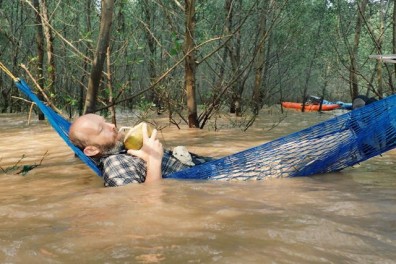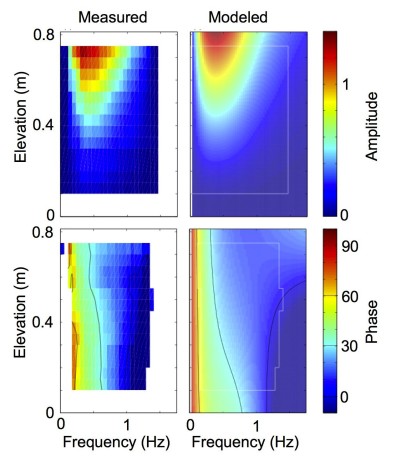Worldwide, numerous saltmarshes have been destroyed by land drainage and reclamation. Marshes provide extensive, diverse and productive habitats for many organisms, while providing us with many valuable ecosystem services (e.g. sheltering coastlines from waves and Tsunamis, encouraging sediment deposition and preventing erosion, burying carbon, and processing pollution). In previous work, we studied the dissipation of waves by flexible vegetation. Ongoing work is examining flow through mangrove canopies, and forcing of mean currents by waves propagating through vegetation.
Mangroves
During 2014-2016, the Environmental Hydrodynamics Laboratory is measuring flows within mangrove swamps in New Zealand and in Vietnam’s Mekong Delta. This work is carried out in collaboration with Julia Mullarney and Karin Bryan of the University of Waikato, and is supported by funding from the US Office of Naval Research and the New Zealand Marsden Fund. During summer 2015, we also worked with WSU applied mathematicians Nick Strigul and Jean Lienard, and NSF REU summer student Kendra Lynn, who have developed new techniques for reconstructing the 3d geometry of Vietnamese mangroves from photographic surveys (published in Estuarine, coastal, and shelf science). A movie showing a 3d reconstruction of mangrove pneumatophores in a 0.25 m^2 quadrat is available from dropbox. Vietnam fieldwork is complete, a series of papers have been published in a special issue of the journal Continental Shelf Research, another paper is published in the Journal of Geophysical Research, and further analysis is ongoing (see photos, and a Waikato publicity report). The data set features the first detailed turbulence measurements from within mangrove vegetation.

Flexible vegetation
During a previous Tidal Flats project, funded by the Office of Naval Research, we studied dissipation of waves by a dense canopy of flexible sedge vegetation. This wave dissipation, which creates still waters that encourage sediment deposition, proved to be a fruitful topic for application of video measurements and classical elasticity theory.
Julia Mullarney and Chris Eager developed video measurements of vegetation motion under waves (an example shown below).Julia and Steve Henderson adapted linear-elasticity theory, used for centuries by engineers to simulate stresses in buildings and bridges, to simulate the motion of vegetation under waves. Model-data comparison confirmed the success of the model. This work was published in the Journal of Geophysical Research.


Masters student Kassi Dallavis investigated the bulk dissipation of waves by the mobile vegetation. Her work, which received a Best Student Presentation award at the 2010 WSU Vancouver Research Showcase as well as a Nortek USA Student Equipment Grant, showed that dissipation was substantially reduced by the tendency to vegetation to bend with the waves. This reduction was predicted by the Mullarney/Henderson theory for vegetation motion. This work was published in the Journal Geophysical Research Letters.
More recently, we extended the Mullarney-Henderson theory to account for vegetation buoyancy. This may make the theory useful for simulating motion of kelp and seagrasses. A paper summarizing this theory has been published in the journal Coastal Engineering.
Submerged vegetation is not restricted to saltmarshes, and is common along many coastlines. Future work may test our theory in other environments.